The first coffee trees to be cultivated originated in Ethiopia, and this same variety, Typica, is still widely grown today. Many other varieties now exist, some natural mutations and others the result of cross-breeding. Some varieties have explicit taste characteristics of their own, while others take on their characteristics from the terroir in which they are grown, the way they are cultivated and the way they are processed after harvest.
Few coffee consumers are aware that there are different varieties of the Arabica coffee tree, mainly because much of the world’s coffee always has been, and still is, traded by origin. A particular lot may come from many farms and, by the time of export, no one knows which varieties the contributing producers had grown, only which part of the world it was grown in. This is starting to change, but we still know relatively little about how much impact the variety of the tree can have on the taste of the cup of coffee.
Please note that the descriptions of the most common varieties below will not include any specific notes on taste, unless there is something definite and distinct. So many factors influence cup quality and, coupled with the lack of organized research on the way this can be influenced by variety, it would be misleading to make any bold claims in these pages.
VARIETIES AND VARIETALS
There is often some confusion over the terms ‘variety’ and ‘varietal’. Varieties are genetically distinct variations of a single species, in this case Coffea arabica, that may show different characteristics in the tree structure, leaves or fruit. ‘Cultivar’ is another acceptable term to use here, as this is just a truncation of ‘cultivated variety’.
‘Varietal’ should be used when referring to a specific instance of a variety. When referring to the production of one farm, for example, it would be correct to say that it was one hundred per cent Bourbon varietal.
TYPICA
This is considered the original variety from which all other varieties have mutated or been genetically selected. The Dutch were the first to spread coffee around the world for commercial production and this was the variety they took with them. The fruit is usually red and Typica is capable of producing excellent cup quality, though with a relatively small yield compared to other varieties. It is still grown extensively in many different parts of the world and, as a result, is known by several different names including criollo, sumatra and arabigo.
BOURBON
This was a natural mutation of Typica, which occurred on the island of Réunion (at the time called Bourbon). The yield is higher than that of Typica, and many in the speciality industry believe that it has a distinctive sweetness, making it prized and desirable. There are various variations in the colour of the fruit: red, yellow and occasionally orange. This variety was grown very widely in the past but in many producing countries it was replaced by higher-yielding varieties. This was at a time when the market had not yet matured sufficiently to reward a high enough price to compensate for the lower yields it produces compared to newer varieties.
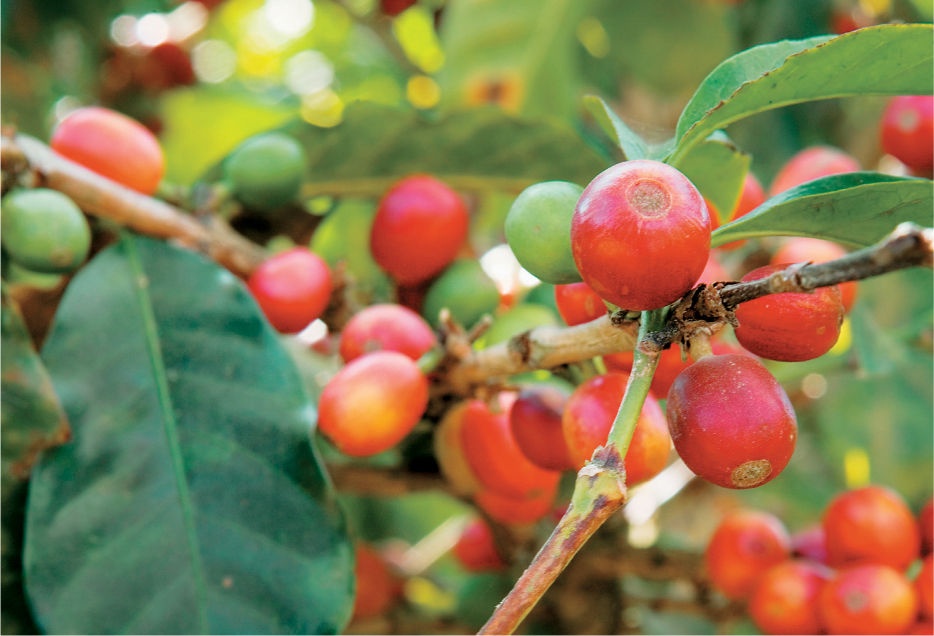 Bourbon
Bourbon
MUNDO NOVO
A natural hybrid of Typica and Bourbon, this variety was named after the place in Brazil where it was discovered in the 1940s. It is grown for its relatively high yield, strength and disease resistance, and also for its success at altitudes of around 1,000–1,200m (3,300–3,900 feet) which are common in Brazil.
CATURRA
This is a mutation of Bourbon, discovered in Brazil in 1937. Its yields are relatively high, though it has the capacity for overbearing, where the tree produces more fruit than it can sustain and succumbs to die-back. However, good farm management can avoid this situation. This variety has been especially popular in Colombia and Central America, though it is still fairly common in Brazil. Cup quality is considered good, and while quality increases with altitude, yield decreases. There are both red and yellow variations and it is a low-growing variety, often referred to as dwarf or semi-dwarf, popular because they are easier to pick by hand.
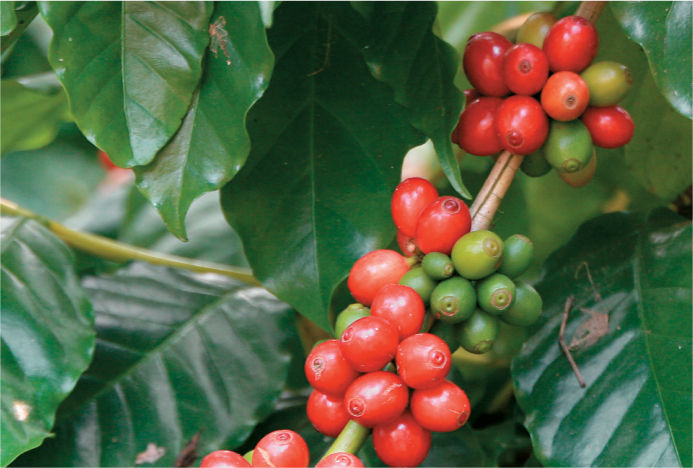 Caturra
Caturra
CATUAI
This is a hybrid between Caturra and Mundo Novo created by the Instituto Agronomico do Campinas in Brazil in the 1950s and 1960s. It was selected as it combined the dwarf characteristics of Caturra with the yield and strength of Mundo Novo. Like Caturra, there are red and yellow varieties.
MARAGOGYPE
One of the more easily recognized varieties, Maragogype is a mutation of Typica, first discovered in Brazil. It is notable, and often considered desirable, due to the unusually large size of its beans. The tree also has exceptionally large leaves but a relatively low yield. This coffee is often referred to as ‘Elephant’ or ‘Elephant Bean’ coffee due to its size. The fruits usually ripen red.
SL-28
A now prized variety, SL-28 was created in Kenya by Scott Laboratories in the 1930s, selected from a drought-resistant variety from Tanzania. The fruits are red when ripe and the beans are notably larger than average. This variety is considered to be capable of producing a cup with a distinct fruit flavour, often described as blackcurrant. It is quite susceptible to coffee leaf rust, and performs better at higher altitudes.
SL-34
This variety was selected from French Mission Bourbon, a variety brought back to Africa from Bourbon (Réunion) and first appearing in Tanzania and then in Kenya. It is also capable of distinct fruit flavours but is generally considered to be inferior to SL-28 in cup quality. It is also susceptible to coffee leaf rust, and the fruits ripen red.
GEISHA OR GESHA
There is some debate over the correct name for this variety, though ‘Geisha’ is more commonly used. Gesha is a town in western Ethiopia and, while the variety was brought to Panama from Costa Rica, it is believed to be Ethiopian in origin. The variety is considered to produce exceptionally aromatic/floral cups, and the demand for it has driven up prices in recent years.
It has gained prominence and popularity dramatically since 2004 when one Panamanian farm, Hacienda La Esmeralda, entered a competition with a Geisha lot. The coffee proved so unusual and distinct that it attracted an incredibly high bid of 130/lb – nearly one hundred times more than a commodity-grade coffee. This has since encouraged many producers in Central and South America to plant this variety.
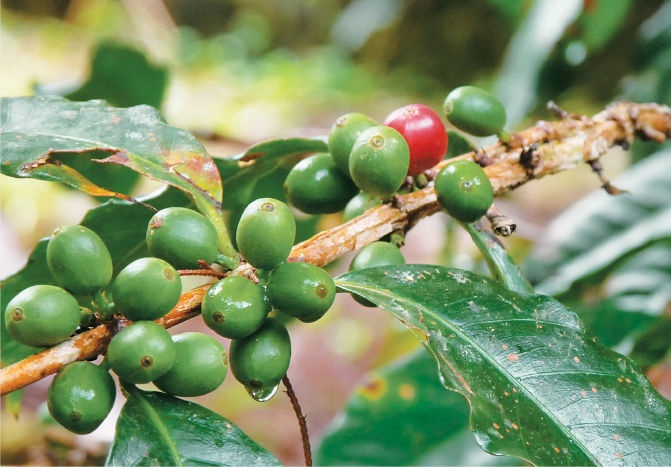 Geisha/Gesha
Geisha/Gesha
PACAS
Pacas is a natural mutation of Bourbon, discovered in El Salvador in 1949 by the Pacas family. It has red fruits and its low-growing habit makes picking easy. Its cup quality is considered similar to Bourbon, and is therefore desirable.
VILLA SARCHI
Named after the town in Costa Rica where it was discovered, this is another natural mutation of Bourbon that, like Pacas, exhibits dwarfism. It is currently being bred to produce very high yields, and it is capable of excellent cup quality. The fruits ripen red.
PACAMARA
This is a cross between the Pacas and Maragogype varieties, created in El Salvador in 1958. Like Maragogype, it has extremely large leaves, fruit and coffee beans. It also has distinct cup characteristics that can be positively described. It can taste like chocolate and fruit, but it also has the capacity for unpleasantly herbal, onion-like cups. The fruits ripen red.
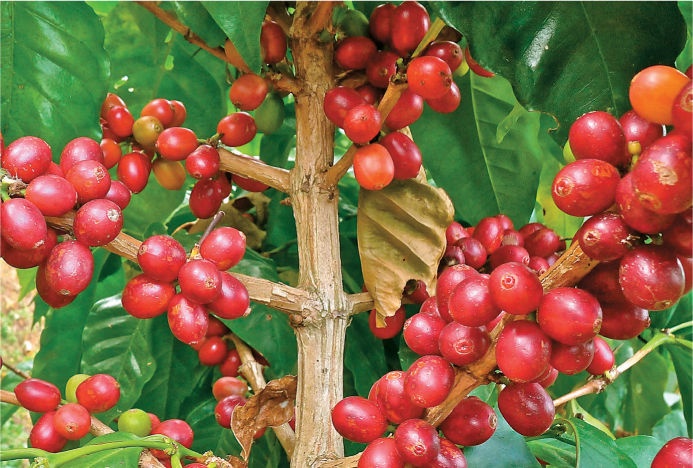 Pacamara
Pacamara
KENT
Named after a planter who worked on a selection programme in India in the 1920s, this variety was developed for its resistance to coffee leaf rust, though it can be destroyed by new strains of the disease.
S795
Also developed in India, this is a cross between Kent and S288, an older selection resistant to coffee leaf rust. It is widely planted in India and Indonesia, although it is now considered to have lost much of its resistance.
WILD ARABICA VARIETIES
Most of the above varieties are genetically extremely similar, as they all stem from one variety, Typica. Many of the coffee trees grown in Ethiopia, however, are not selected cultivars, but are indigenous heirloom varieties that probably result from cross-breeding between different species as well as different varieties. Little work has been done so far to catalogue or explore the genetic diversity and cup quality of these wild varieties.
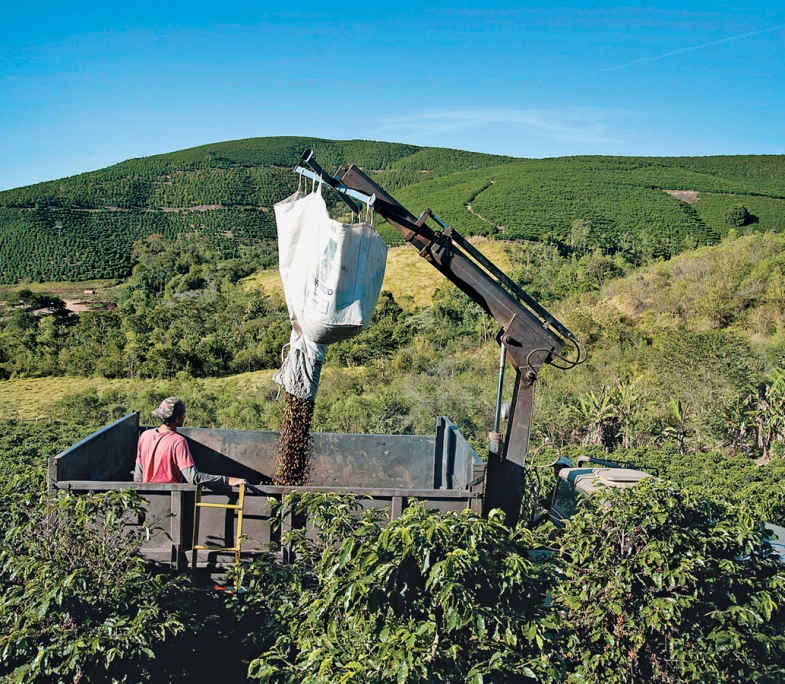 Arabica coffee is harvested by machine in Cabo Verde, Brazil. This method of collecting fruit is efficient, but the harvest must later be sorted to select only ripe cherries.
Arabica coffee is harvested by machine in Cabo Verde, Brazil. This method of collecting fruit is efficient, but the harvest must later be sorted to select only ripe cherries.